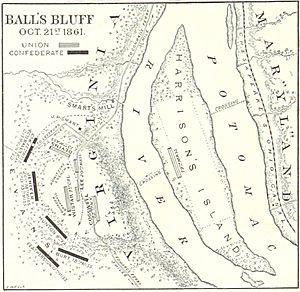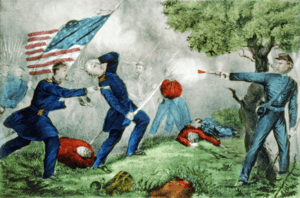Battle of Ball's Bluff facts for kids
Quick facts for kids Battle of Ball's Bluff |
|||||||
|---|---|---|---|---|---|---|---|
| Part of the American Civil War | |||||||
 Depiction of Ball's Bluff by Alfred W. Thompson |
|||||||
|
|||||||
| Belligerents | |||||||
| Commanders and leaders | |||||||
| Charles Pomeroy Stone Edward Dickinson Baker † |
Nathan G. Evans | ||||||
| Strength | |||||||
| 1,720 | 1,709 | ||||||
| Casualties and losses | |||||||
| 921–1,002 total | 155 (36 killed; 117 wounded; 2 captured) | ||||||
The Battle of Ball's Bluff was an early fight in the American Civil War. It happened in Loudoun County, Virginia, on October 21, 1861. Union Army forces, led by Major General George B. McClellan, faced a tough defeat.
This battle started as a small scouting mission across the Potomac River. The goal was to see if Confederate troops were in Leesburg. A false report about an unguarded Confederate camp led Brigadier General Charles Pomeroy Stone to order a surprise attack. This attack quickly turned into a battle.
A U.S. Senator named Colonel Edward Dickinson Baker joined the Union troops. He tried to send more soldiers across the river. But there weren't enough boats, which caused big delays. Colonel Baker was killed during the fighting. A new Confederate unit then arrived and defeated the rest of Stone’s troops.
Even though the Union losses were not huge compared to later battles, they worried the U.S. Congress. This led to the creation of the United States Congress Joint Committee on the Conduct of the War. This committee caused many disagreements among leaders for years.
Contents
Why the Battle of Ball's Bluff Happened
Three months after the First Battle of Bull Run, Major General George B. McClellan was building up the Army of the Potomac. He was getting ready to move his army into Virginia.
On October 19, 1861, McClellan told Brigadier General George A. McCall to march his troops to Dranesville, Virginia. This town was about twelve miles southeast of Leesburg. The goal was to find out why Confederate troops were moving around. It seemed like Colonel Nathan G. Evans might have left Leesburg.
Evans had actually left the town a few days earlier. But Confederate Brigadier General P. G. T. Beauregard was not happy about this. So, Evans returned to Leesburg. By the evening of October 19, he had set up defenses east of town.
McClellan met with McCall that same evening. He ordered McCall to return to his main camp the next morning. But McCall asked for more time to map the roads. So, he didn't leave until the morning of October 21. This was just as the fighting at Ball's Bluff was starting.
How the Battle Started: A "Slight Demonstration"
On October 20, while McCall was mapping, McClellan gave another order. He told Brigadier General Charles Pomeroy Stone to do a "slight demonstration." This meant a small show of force to see how the Confederates would react.
Stone moved his troops to the river at Edwards Ferry. He also placed other forces along the river. His cannons fired into areas where Confederates might be hiding. He even sent about a hundred men across the river to the Virginia side. But Colonel Evans didn't react. So, Stone called his troops back.
Stone then ordered Colonel Charles Devens to send a patrol across the river. Devens was with the 15th Massachusetts Infantry on Harrison's Island. This island was across from Ball's Bluff. The patrol was to gather information about enemy troops.
Captain Chase Philbrick and about 20 men went on this patrol. It was dark, and they went almost a mile inland. Philbrick was new to this and thought a line of trees looked like a Confederate camp. Without checking closely, he reported seeing a camp.
Stone immediately ordered Devens to send about 300 men across the river. As soon as it was light, they were to attack the camp. Then, they were to return to their starting position. This was the beginning of the Battle of Ball's Bluff. It wasn't planned as a big attack to take Leesburg. It started as a small scouting mission, then became a raiding party. Stone also didn't know that McCall's division had been ordered back to Washington.
Who Fought at Ball's Bluff
Union Forces
Confederate Forces
The Battle Unfolds
On the morning of October 21, Colonel Devens' raiding party found out the mistake. There was no camp to attack. Devens decided not to cross back right away. He placed his men in a line of trees. He sent a messenger back to Stone for new orders.
Stone heard the report. He told the messenger to tell Devens that more troops would cross. The rest of the 15th Massachusetts (about 350 men) would join him. Once they arrived, Devens was to change his mission from a raid to scouting towards Leesburg.
While the messenger was returning to Devens, Colonel Edward Dickinson Baker arrived at Stone's camp. Baker was also a U.S. Senator. He wanted to know what was happening. Stone told him about the mistake and the new orders. He then told Baker to go to the crossing point. Baker was to decide whether to bring the troops back or send more across.
On his way, Baker met Devens' messenger again. The messenger reported that Devens' men had met and briefly fought some Confederates. It was one company from the 17th Mississippi Infantry.
Baker immediately ordered as many troops as possible to cross the river. But he didn't check how many boats were available. This caused a big traffic jam. Union troops could only cross slowly and in small groups. The crossing took all day.
Meanwhile, Devens' men, now about 650 strong, stayed in their advanced position. They had two more small fights with a growing number of Confederates. Other Union troops crossed the river but stayed near the bluff. They did not move forward.
Devens finally pulled back around 2:00 p.m. He met Baker, who had finally crossed the river half an hour later. Around 3:00 p.m., the main fighting began. It continued almost without stopping until after dark.
Colonel Baker was killed around 4:30 p.m. He is the only U.S. Senator ever killed in battle. After a failed attempt to break out, the Union soldiers began to cross back over the river. It was very disorganized. Just before dark, a fresh Confederate regiment arrived. This was the 17th Mississippi. They led a final attack that completely broke the Union troops.
Many Union soldiers were forced down a steep slope into the river. Boats trying to cross back to Harrison Island quickly sank. Many soldiers, including some who were wounded, drowned. Bodies floated down the river to Washington and even as far as Mount Vernon.
In total, 223 Union soldiers were killed. Another 226 were wounded, and 553 were captured. Fifty-four Union soldiers are buried at Ball's Bluff Battlefield and National Cemetery. Only one of them has been identified.
This battle is also known as the Battle of Harrison’s Island or the Battle of Leesburg.
What Happened After the Battle
This Union defeat was small compared to later battles. But it had a huge impact. The Union lost 223 soldiers and a sitting senator. This caused big political problems in Washington.
Stone was blamed for the defeat. But some members of Congress thought there might have been a plot to betray the Union. People were upset about losing battles at Bull Run, Wilson's Creek, and Ball's Bluff. This led to the creation of the U.S. Congress Joint Committee on the Conduct of the War. This committee caused trouble for Union officers for the rest of the war.
Lt. Oliver Wendell Holmes, Jr., from the 20th Massachusetts Volunteer Infantry, was badly wounded at Ball's Bluff. He survived and later became a very important judge in 1902. Herman Melville's poem "Ball's Bluff – A Reverie" (written in 1866) remembers the battle.
Lt. Henry Livermore Abbott, a friend of Holmes, also survived the battle but died later in the war. Another officer, Edmund Rice, also became a general and won the Medal of Honor. He was lucky enough to survive the war. The death of 2nd Lt. John William Grout inspired a poem and song called "The Vacant Chair".
Saving the Battlefield
The place where the battle happened is now preserved as the Ball's Bluff Battlefield and National Cemetery. It was named a National Historic Landmark in 1984. The Northern Virginia Regional Park Authority takes care of the park.
The battlefield has been restored to look much like it did in 1861. Volunteer guides give tours every weekend in the spring, summer, and fall. The Civil War Trust has also helped save about 3 acres (1.2 hectares) of the battlefield.
Ball's Bluff in Books and Stories
Bernard Cornwell's book Copperhead starts with the Battle of Ball's Bluff. It's the second book in The Starbuck Chronicles series. In the story, a fictional group of soldiers helps defeat the Union forces.
Geraldine Brooks' book March also begins with the Battle of Ball's Bluff. This book won a big award in 2006. In the story, Mr. March, the father from Little Women, is a chaplain with the Union army.
Along the Chesapeake and Ohio Canal in Maryland, people used to say that ghosts of soldiers haunted the area. These were soldiers who drowned in the Potomac River during the battle. Canal workers would not stay there overnight because of these rumors.
The poem "The Vacant Chair" was written by Henry S Washburn. It was written to remember Lt. John William Grout, who died at Ball's Bluff. George F. Root set it to music. It became popular in both the North and South because it spoke about the sadness of losing someone.




